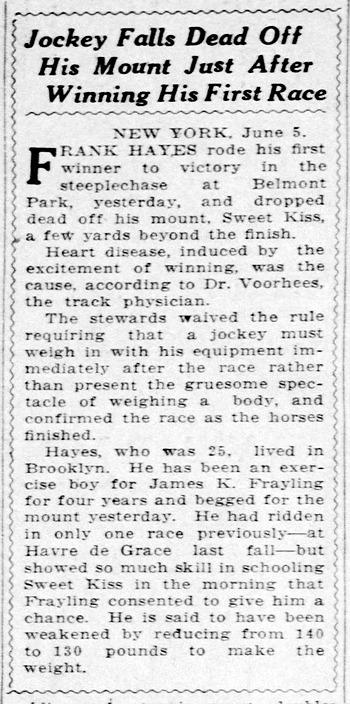The strange death of Frank Hayes
June 4, 1923: Jockey Frank Hayes suffered a heart attack and died while riding the horse Sweet Kiss in the steeplechase at Belmont Park. He nevertheless won the race.
It's the only time that a horse race has been won by a dead jockey. And it's probably also the only time that a sports competition has been won by a dead contestant.
More info: wikipedia

It's the only time that a horse race has been won by a dead jockey. And it's probably also the only time that a sports competition has been won by a dead contestant.
More info: wikipedia

St. Louis Post-Dispatch - June 5, 1923
Comments
If he was alive when he crossed the finish line as the article states then the race, or any competition, was not won by a dead contestant.
Posted by F.U.D in Stockholm on 07/09/20 at 10:30 AM
It says he "dropped dead off his mount" beyond the finish line, which is kind of ambiguous. Did he "drop dead" or "drop, dead?" According to the Wikipedia article and its sources, the latter interpretation is correct. He died during the race, and his body fell off the saddle after the race.
Posted by ges on 07/09/20 at 11:32 AM
I would guess there's no way to determine exactly when he died. There are a few verified cases (vs the number of times it was said to happen in tabloids of the time) in the old west of a horse walking up to a town/farm with a dead rider in the saddle (the one I remember best, the guy had been shot in the back of the head). Unfortunately, it didn't happen often enough, and people were too freaked out to make accurate observations or take measurements, so the exact mechanics of it are conjecture. It's assumed that, slumped forward, the body might have been stabilized by the saddle horn while the stirrups prevented oscillations of the legs which might have unbalanced the load.
A race horse has a smooth enough rhythm that it might have taken a considerable time, relatively speaking, before the body was jarred loose.
If we knew more about the journalist's definition of "a few yards," it would help a lot. One or even two horse-lengths would make a death-before-the-line plausible, while the probability drops sharply after that.
It'd be really interesting to see the image captured by the photo-finish camera. It might be obvious proof one way or another, or it might add considerably to the frustration.
A race horse has a smooth enough rhythm that it might have taken a considerable time, relatively speaking, before the body was jarred loose.
If we knew more about the journalist's definition of "a few yards," it would help a lot. One or even two horse-lengths would make a death-before-the-line plausible, while the probability drops sharply after that.
It'd be really interesting to see the image captured by the photo-finish camera. It might be obvious proof one way or another, or it might add considerably to the frustration.
Posted by Phideaux on 07/09/20 at 11:39 AM
Judging from this article, they didn't have photo finishes in 1923.
https://blogs.scientificamerican.com/anecdotes-from-the-archive/winning-in-a-snap-a-history-of-photo-finishes-and-horse-racing/
https://blogs.scientificamerican.com/anecdotes-from-the-archive/winning-in-a-snap-a-history-of-photo-finishes-and-horse-racing/
Posted by ges on 07/09/20 at 02:24 PM
In any case, he's certainly not the only, nor by two and a half millennia the first, person to die during a sports contest and still win it. During the 54th ancient Olympics, over 500 years BC, one Arrichion of Phigalia won the infamous pankration by making his opponent submit (because of the pain of Arrichion's lockhold) at the same time that that opponent's choke-hold proved fatal. Since Arrichion had died, but not submitted, he was declared the winner.
Posted by Richard Bos on 07/11/20 at 08:57 AM
I don't think racing saddles have saddle horns.
Posted by Joshua Zev Levin, Ph.D. on 07/19/20 at 11:45 AM
That's part of the accepted conjecture concerning bodies staying in saddle in the old west.
On a racing saddle, the usual position is virtually laying on the horse's back. Combined with how the legs are held high, little other stabilization would be needed.
On a racing saddle, the usual position is virtually laying on the horse's back. Combined with how the legs are held high, little other stabilization would be needed.
Posted by Phideaux on 07/19/20 at 01:17 PM
Commenting is not available in this channel entry.



Category: Death | Sports | 1920s